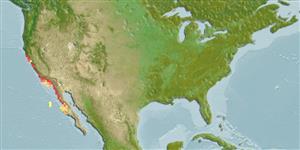>
Blenniiformes (Blennies) >
Chaenopsidae (Pike-, tube- and flagblennies)
Etymology: Neoclinus: Greek,neos = new + Greek, klinein, kline = sloping and bed, due to the four apophyses of sphenoid bone (Ref. 45335); uninotatus: Neoclinus new Clinus ; uninotatus one mark, for the single ocellatus (Ref. 4930).
Environment: milieu / climate zone / distribuzione batimetrica / distribution range
Ecologia
marino demersale; distribuzione batimetrica 3 - 27 m (Ref. 2850). Subtropical; 39°N - 27°N, 124°W - 114°W
Eastern Pacific: Bodega Bay in northern California, USA to northern Baja California, Mexico.
Length at first maturity / Size / Peso / Age
Maturità: Lm 8.9 range ? - ? cm
Max length : 25.0 cm TL maschio/sesso non determinato; (Ref. 2850); Età massima riportata: 7 anni (Ref. 43439)
Usually occurs on bottom along coast and in bays. Lives inside objects, including bottles, cans, and tires.
Females lay eggs in abandoned boring clam holes, under rocks, in beer containers, and other containers. Males guard the eggs until they hatch (Ref. 43439).
Eschmeyer, W.N., E.S. Herald and H. Hammann, 1983. A field guide to Pacific coast fishes of North America. Boston (MA, USA): Houghton Mifflin Company. xii+336 p. (Ref. 2850)
IUCN Red List Status (Ref. 130435: Version 2025-1)
Threat to humans
Harmless
Human uses
Strumenti
Special reports
Download XML
Fonti Internet
Estimates based on models
Preferred temperature (Fonte Biblio.
123201): 12.8 - 19, mean 15.9 °C (based on 43 cells).
Phylogenetic diversity index (Fonte Biblio.
82804): PD
50 = 0.5005 [Uniqueness, from 0.5 = low to 2.0 = high].
Bayesian length-weight: a=0.00525 (0.00219 - 0.01260), b=3.06 (2.85 - 3.27), in cm total length, based on LWR estimates for this (Sub)family-body shape (Ref.
93245).
Trophic level (Fonte Biblio.
69278): 3.5 ±0.50 se; based on food items.
Resilienza (Fonte Biblio.
120179): Medio, tempo minimo di raddoppiamento della popolazione 1.4 - 4.4 anni (tm=1; tmax=7; Fec = 600).
Fishing Vulnerability (Ref.
59153): Low vulnerability (15 of 100).
🛈
